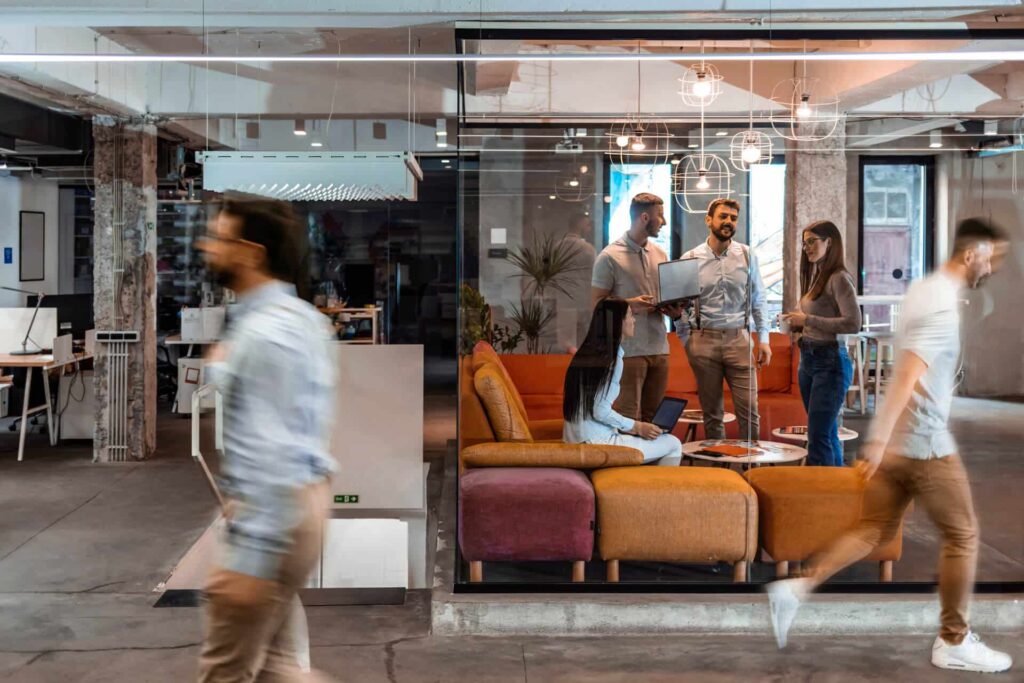Working neighborhoods have become an increasingly popular workplace strategy. This is thanks in large part to how they can create a much more efficient and collaborative office. This is typically achieved by improving hybrid work and flexible seating strategies like hot desking.
In response to this new way of working, OfficeSpace has created an elegant Office Neighborhoods feature. It incorporates bookable desks, adding a level of workspace flexibility that is unique in the market.
To better understand how organizations can optimize their neighborhood seating to improve their working groups (or neighborhoods), we sat down for a two-part interview with Jordan Y. Jordan is an OfficeSpace Product Manager who helped lead the creation of Office Neighborhoods.
OfficeSpace developers are a collaborative bunch! So Jordan has first-hand insight into why fostering collaboration in the office is so important. Combined with his experience and extensive use of client feedback, Jordan is an expert in optimizing this workplace strategy in virtually any office environment.

Working neighborhoods: strategies
In this interview, we’re doing a deep dive into the strategies behind all good working neighborhoods. Specifically, we’ll explore:
- Why working in neighborhoods is so beneficial—and why using Office Neighborhoods is the best way to realize these benefits
- What to do if you want to have neighborhoods that are in separate sections of the office (i.e.: non-contiguous neighborhoods)
- Whether more traditional offices can or should use Office Neighborhoods
- What companies and employees benefit most from Office Neighborhoods
- How to choose between seating arrangements
- What makes a successful neighborhood—and how to make working in neighborhoods even better
“When used well, Office Neighborhoods can make the office a much more fun place to work, and they can invite people back to an environment that—let’s face it—has changed a lot in the last two years. It’s a welcoming and pleasant way to encourage people to give the office another shot in a very different world than it was before the pandemic.”
Jordan Y., Product Manager, OfficeSpace Software
In the next installment of this series, we’ll explore specific ways organizations can use this new feature to maximize their neighborhood layout. Both are essential reads for anyone looking to create a more vibrant and productive workplace. But first, let’s dive into Office Neighborhood strategies.
Why did your team create an Office Neighborhoods feature?
Neighborhoods are a way of making the OfficeSpace platform more relevant, useful and fun for people, while also lessening the workload of whoever is in charge of the facility.
We were getting a lot of feedback from large tech companies that had very large floor plans, with more of a campus environment. They needed a more lively way of demarcating their floor plan into smaller portions. They also really wanted to be able to evenly delegate the workload associated with managing seating arrangements.
Not only does using Office Neighborhoods make this process more demarcated and visually stimulating, but each one of our neighborhoods can be assigned with what we call a Captain. The Captain is the person who will be in charge of the little neighborhood that was drawn on that giant floor plan, handling many tasks that were once facility manager (FM) responsibilities.
You can even have up to five captains in a neighborhood if you really want to split up and share the workload evenly.
What separates OfficeSpace’s Neighborhoods from others on the market?
With our platform you can really get creative with neighborhoods and bookable desks—they combine together really nicely. And then you’ve got a Neighborhood Captain on top of that who can play air traffic control. It all works quite intuitively and in a way that doesn’t overwhelm people. Especially those who may not be familiar with facility management software.
Most Neighborhood Captains are not FMs, so they probably don’t know a lot about facility management. We’ve made a platform that makes it easy for anyone to figure out who needs to sit where. It’s more intuitive, and it integrates seamlessly with bookable seating, making it better for space use.
Another really important and unique feature is the ability to make non-contiguous neighborhoods—they don’t have to be one big block. With other competitors, you might have to draw very awkward shapes that have a kind of umbilical cord linking the two together. But with OfficeSpace, you can actually draw separate shapes, completely unconnected, that can be linked to one neighborhood. It’ll share the same membership list, it will have the same captains, it will highlight both positions on the map—everything. And you can do that an unlimited number of times. I’ve seen people with neighborhoods that had ten or more segments that were not connected.

How can using Office Neighborhoods help to reduce your workload?
Captains can take a big workload off of their FM’s shoulders. Then, having good lists of who is allowed to dwell in each neighborhood can really simplify things further.
There are several options for these lists, including an automated one that can admit people based on certain criteria. So your employee files might have things like ‘supervisor name’ or ‘locale’ or other data points. You can actually make up to 35 custom fields, along with the built-in standard options. We can leverage any of those data points you might have to dynamically admit people to a neighborhood. Without user intervention.
So there’s a lot of ways that you can reduce workload. Even for the Captains, who themselves are reducing the workload. It’s a pretty cool feature.
We tend to associate working neighborhoods with the hybrid workplace. Is there any benefit to using OfficeSpace Neighborhoods in a traditional office?
I definitely think that neighborhoods work better in hybrid offices. This is because you really get your money’s worth when you have bookable seating. There’s a lot less movement in a neighborhood if you’re talking about a traditional seating arrangement. But it can still be helpful, especially for wayfinding components on the floor plan. If you’re trying to locate things or trying to navigate a large floor plan, a neighborhood can help with that from a visual perspective.
Very traditional offices, like law firms, can also really benefit from the reporting components. Especially when it comes to calculating space utilization and headcounts.
And if we’re talking about a medium-sized traditional organization that has a lot of assigned desks but then maybe a few bookable ones, a neighborhood would instantly become even more relevant for stakeholders, too.
Ultimately, the relevancy increases with the concentration of bookable seating, but there’s selling points for every use case scenario.

OfficeSpace lets you create agile neighborhoods that are team-based or activity-based, along with open seating, too. Can these options be blended in one neighborhood? How should a company choose which to use for their workplace?
You absolutely can have a blend of seating arrangements within a neighborhood. What you choose really comes down to what you’re trying to accomplish. If we’re talking about large software companies that have lots of people traveling and lots of different teams, I think they’d benefit from having a neighborhood setup with dynamic rules. They could have admission requirements such as manager name or even a project type. And they could make it most complete by having a number of bookable seats in that neighborhood.
But you really can mix and match as necessary. Having a team specific neighborhood with robust admission requirements and dynamic rules usually works well.
Who benefits the most from working neighborhoods?
I find companies in the software space and the pharmaceuticals industry are really benefiting from Neighborhoods, simply owing to the way their people work.
The employees who benefit most are those who travel a lot and those who like to collaborate. Even though they may not always be in the same space at the same time. Thanks to the nature of how they work, people who really like to collaborate will really like neighborhoods.
“Collaboration and democratization are the two words that I associate most with the benefits you can get from a neighborhood.”
Plus, the fact that you usually have a peer running the neighborhoods as the Captain, who also works in the neighborhood, can really democratize the ability to come to work.
For example, maybe an employee will end up wanting a permanent desk. Their Captain can easily do that for them, without having to go through bureaucracy or facility management.
What makes working in neighborhoods successful?
In the office neighborhood examples I’ve seen, I’ve found that the clients that get the most value out of neighborhoods don’t look to strictly make the neighborhood fit the office. Instead, they adjust the office a little bit to make for a vibrant neighborhood.
For example, the OfficeSpace platform doesn’t just cover desk and room booking. You can also use it to find utilities like printers and whatnot. The clients who have really gotten their money’s worth out of the solution have been open to the idea of not just creating a neighborhood, but moving a few other things around to make everything better.
Maybe your neighborhood should have some printers with links to drivers. And maybe you have people coming in to book a desk who don’t have a driver on their laptop. OfficeSpace can provide the solution—as any utility icon can include links to related resources or websites.
So there are lots of ways of really making neighborhoods work well. When I see clients make that little extra effort, the return on investment for them is quite big and quite meaningful. Not just for the company but for the quality of life of the people who dwell in the neighborhood, too.
What are some examples of OfficeSpace clients doing interesting things with the neighborhoods feature?
A lot of clients do interesting things with the user defined fields (UDF). Remember that the platform has built-in fields for each employee, and you can also create up to 35 unique fields. I’ve had very interesting applications where clients have created a UDF, denoting if someone has a peanut allergy or other food allergy. That way, you won’t have someone with an allergy sitting next to someone who has a peanut butter bagel each morning.
So you can do a lot of different things to mitigate concerns or risks, or make the list more convenient or relevant to where you work.

Finally, what is the best way to optimize an existing neighborhood?
There are several ways to optimize an existing neighborhood; here are three ideas to start:
1. Use Office Neighborhoods as an inspiration
First, don’t just expect the Neighborhood software to solve all your problems. It should be more the inspiration behind creating a healthy neighborhood. Neighborhoods are meant to be a healthy environment to get work done with people who like to work together and frequently are in the office. Be aware of what neighborhoods do best, and try to configure them in a way that works for that.
2. Make your Office Neighborhoods the right size
Second, don’t make your neighborhoods too big. Technically, OfficeSpace lets you make them as big as you want. But I’ve seen some examples where a neighborhood has 3000 members, but only 50 desks. That’s not really what we designed these for. I doubt very much that 3000 people are regularly occupying a neighborhood with 50 desks.
I think our lists are a really key thing. Make sure your lists are working properly for you because they can really cut down on the workload. Dynamic lists in particular can help accommodate new hires when they’re configured properly. This alleviates the need to manually add new names to the neighborhood.
So make sure you keep your lists up to date. And if you are leveraging dynamic tools, make sure the criteria of who’s being admitted and who isn’t still continues to work.
3. Have more than one Neighborhood Captain
Finally, having more than one Captain is also helpful. In my experience, Captains usually don’t have extensive facility management experience or much familiarity with CAFM/IWMS software like OfficeSpace. Doubling up on captains can really help reduce any knowledge gaps here. It’s also important if your desk booking system requires manual approval. You don’t want to leave people hanging just because a Captain calls in sick or is on PTO.
It’s also good to have Captains dwell in the neighborhood so that they have their boots on the ground. That way they know whether the neighborhood is actually working or not.
Then facility managers can be regularly checking in with their Captains to ensure things are working the way they want. This way, they can ensure they are configuring everything in a way that’s complementary and supports their Captains. And therefore their employees, too.
Don’t miss our next interview with Jordan. We explore specifically how to use Office Neighborhoods to make better neighborhood layouts. We cover unique features, plus how to use them to better plan offices and open spaces, implement flexible working strategies, and improve your real estate portfolio.
Read the next installment of this interview: Neighborhood layout: A feature deep dive, part 2
OfficeSpace offers elegant software to radically improve working neighborhoods. Reach out for a free demo.
Photos: JimmyFam, Vasyl Dolmatov, g-stockstudio, ljubaphoto




